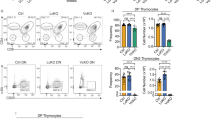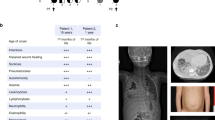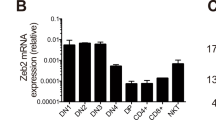Abstract
Mice carrying the recessive locus for peripheral T cell deficiency (Ptcd) have a block in thymic egress, but the mechanism responsible is undefined. Here we found that Ptcd T cells had an intrinsic migration defect, impaired lymphoid tissue trafficking and irregularly shaped protrusions. Characterization of the Ptcd locus showed a point substitution of lysine for glutamic acid at position 26 in the actin regulator coronin 1A that enhanced its inhibition of the actin regulator Arp2/3 and resulted in its mislocalization from the leading edge of migrating T cells. The discovery of another coronin 1A mutant during an N-ethyl-N-nitrosourea-mutagenesis screen for T cell–lymphopenic mice prompted us to evaluate a T cell–deficient, B cell–sufficient and natural killer cell–sufficient patient with severe combined immunodeficiency, whom we found had mutations in both CORO1A alleles. Our findings establish a function for coronin 1A in T cell egress, identify a surface of coronin involved in Arp2/3 regulation and demonstrate that actin regulation is a biological process defective in human and mouse severe combined immunodeficiency.
This is a preview of subscription content, access via your institution
Access options
Subscribe to this journal
Receive 12 print issues and online access
$209.00 per year
only $17.42 per issue
Buy this article
- Purchase on Springer Link
- Instant access to full article PDF
Prices may be subject to local taxes which are calculated during checkout







Similar content being viewed by others
References
Schwab, S.R. & Cyster, J.G. Finding a way out: lymphocyte egress from lymphoid organs. Nat. Immunol. 8, 1295–1301 (2007).
Ohtori, H., Yoshida, T. & Inuta, T. “Small eye and cataract,” a new dominant mutation. Exp. Anim. 17, 91–96 (1968).
Yagi, H. et al. Defect of thymocyte emigration in a T cell deficiency strain (CTS) of the mouse. J. Immunol. 157, 3412–3419 (1996).
Ikegami, H., Makino, S., Harada, M., Eisenbarth, G.S. & Hattori, M. The cataract Shionogi mouse, a sister strain of the non-obese diabetic mouse: similar class II but different class I gene products. Diabetologia 31, 254–258 (1988).
Uetrecht, A.C. & Bear, J.E. Coronins: the return of the crown. Trends Cell Biol. 16, 421–426 (2006).
Foger, N., Rangell, L., Danilenko, D.M. & Chan, A.C. Requirement for coronin 1 in T lymphocyte trafficking and cellular homeostasis. Science 313, 839–842 (2006).
Haraldsson, M.K. et al. The lupus-related Lmb3 locus contains a disease-suppressing Coronin-1A gene mutation. Immunity 28, 40–51 (2008).
Mueller, P. et al. Regulation of T cell survival through coronin-1-mediated generation of inositol-1,4,5-trisphosphate and calcium mobilization after T cell receptor triggering. Nat. Immunol. 9, 424–431 (2008).
Kimura, S. et al. Genetic control of peripheral T-cell deficiency in the cataract Shionogi (CTS) mouse linked to chromosome 7. Immunogenetics 47, 278–280 (1998).
Ohotori, H., Yoshida, T. & Inuta, T. Small eye and cataract, a new dominant mutation in the mouse. Jikken Dobutsu 17, 91–96 (1968).
Nal, B. et al. Coronin-1 expression in T lymphocytes: insights into protein function during T cell development and activation. Int. Immunol. 16, 231–240 (2004).
Appleton, B.A., Wu, P. & Wiesmann, C. The crystal structure of murine coronin-1: a regulator of actin cytoskeletal dynamics in lymphocytes. Structure 14, 87–96 (2006).
Cai, L., Makhov, A.M. & Bear, J.E. F-actin binding is essential for coronin 1B function in vivo. J. Cell Sci. 120, 1779–1790 (2007).
Maltzman, J.S., Kovoor, L., Clements, J.L. & Koretzky, G.A. Conditional deletion reveals a cell-autonomous requirement of SLP-76 for thymocyte selection. J. Exp. Med. 202, 893–900 (2005).
Cai, L., Marshall, T.W., Uetrecht, A.C., Schafer, D.A. & Bear, J.E. Coronin 1B coordinates Arp2/3 complex and cofilin activities at the leading edge. Cell 128, 915–929 (2007).
Ghebranious, N., Giampietro, P.F., Wesbrook, F.P. & Rezkalla, S.H. A novel microdeletion at 16p11.2 harbors candidate genes for aortic valve development, seizure disorder, and mild mental retardation. Am. J. Med. Genet. A. 143, 1462–1471 (2007).
Weiss, L.A. et al. Association between microdeletion and microduplication at 16p11.2 and autism. N. Engl. J. Med. 358, 667–675 (2008).
Kumar, R.A. et al. Recurrent 16p11.2 microdeletions in autism. Hum. Mol. Genet. 17, 628–638 (2008).
Sakata, D. et al. Impaired T lymphocyte trafficking in mice deficient in an actin-nucleating protein, mDia1. J. Exp. Med. 204, 2031–2038 (2007).
Nombela-Arrieta, C. et al. A central role for DOCK2 during interstitial lymphocyte motility and sphingosine-1-phosphate-mediated egress. J. Exp. Med. 204, 497–510 (2007).
Carman, C.V. et al. Transcellular diapedesis is initiated by invasive podosomes. Immunity 26, 784–797 (2007).
Gallego, M.D. et al. WIP and WASP play complementary roles in T cell homing and chemotaxis to SDF-1α. Int. Immunol. 18, 221–232 (2006).
Snapper, S.B. et al. WASP deficiency leads to global defects of directed leukocyte migration in vitro and in vivo. J. Leukoc. Biol. 77, 993–998 (2005).
Reif, K. et al. Cutting edge: differential roles for phosphoinositide 3-kinases, p110γ and p110δ, in lymphocyte chemotaxis and homing. J. Immunol. 173, 2236–2240 (2004).
Nombela-Arrieta, C. et al. Differential requirements for DOCK2 and phosphoinositide-3-kinase γ during T and B lymphocyte homing. Immunity 21, 429–441 (2004).
Lammermann, T. et al. Rapid leukocyte migration by integrin-independent flowing and squeezing. Nature 453, 51–55 (2008).
Humphries, C.L. et al. Direct regulation of Arp2/3 complex activity and function by the actin binding protein coronin. J. Cell Biol. 159, 993–1004 (2002).
Rodal, A.A. et al. Conformational changes in the Arp2/3 complex leading to actin nucleation. Nat. Struct. Mol. Biol. 12, 26–31 (2005).
Cai, L., Makhov, A.M., Schafer, D.A. & Bear, J.E. Coronin 1B antagonizes cortactin and remodels Arp2/3-containing actin branches in lamellipodia. Cell (in the press) (2008).
Gallo, E.M., Cante-Barrett, K. & Crabtree, G.R. Lymphocyte calcium signaling from membrane to nucleus. Nat. Immunol. 7, 25–32 (2006).
Puck, J.M. & Candotti, F. Lessons from the Wiskott-Aldrich syndrome. N. Engl. J. Med. 355, 1759–1761 (2006).
Fischer, A. Human primary immunodeficiency diseases. Immunity 27, 835–845 (2007).
Buckley, R.H. The multiple causes of human SCID. J. Clin. Invest. 114, 1409–1411 (2004).
Nelms, K.A. & Goodnow, C.C. Genome-wide ENU mutagenesis to reveal immune regulators. Immunity 15, 409–418 (2001).
Lo, C.G., Xu, Y., Proia, R.L. & Cyster, J.G. Cyclical modulation of sphingosine-1-phosphate receptor 1 surface expression during lymphocyte recirculation and relationship to lymphoid organ transit. J. Exp. Med. 201, 291–301 (2005).
Shiow, L.R. et al. CD69 acts downstream of interferon-α/β to inhibit S1P1 and lymphocyte egress from lymphoid organs. Nature 440, 540–544 (2006).
Pham, T.H., Okada, T., Matloubian, M., Lo, C.G. & Cyster, J.G. S1P1 receptor signaling overrides retention mediated by Gαi–coupled receptors to promote T cell egress. Immunity 28, 122–133 (2008).
Allen, C.D., Okada, T., Tang, H.L. & Cyster, J.G. Imaging of germinal center selection events during affinity maturation. Science 315, 528–531 (2007).
Okada, T. et al. Antigen-engaged B cells undergo chemotaxis toward the T zone and form motile conjugates with helper T cells. PLoS Biol. 3, e150 (2005).
Acknowledgements
We thank the patient with SCID and her family; M. Anderson, P. Beemiller, S. Cheung, G. Cinamon, M. Krummel, T. Phan, H. Phee and A. Weiss for discussions; and D. Schafer (University of Virginia) for advice and reagents related to the pyrene actin assay. Supported by the University of California, San Francisco Medical Scientist Training Program (L.R.S.), Genentech Sandler Family Foundation (L.R.S.), the US Immunodeficiency Network (J.M.P.), the Jeffrey Modell Foundation (J.M.P.), the Howard Hughes Medical Institute (J.G.C.) and the National Institutes of Health (C.C.G., J.E.B. and J.G.C.).
Author information
Authors and Affiliations
Corresponding author
Supplementary information
Supplementary Text and Figures
Supplementary Figures 1–9 and Supplementary Table 1 (PDF 1616 kb)
Supplementary Movie 1
Comparison of two-photon time-lapse microscopy of control (left) or Ptcd (right) cells labeled in red and wild-type GFP cells in green migrating in the T zone of an explanted lymph node. Yellow tracks generated to aid visualization of representative wild-type GFP cells and white tracks of control (left) or Ptcd (right) cells. (MPG 5465 kb)
Supplementary Movie 2
Brightfield time-lapse microscopy of wildtype lymph node cells on ICAM-coated coverslips in 1 ug/mL CCL21, followed by fluorescent exposure to identify T cells (blue), B cells (red) and dead cells (pink). Tracks generated to aid visualization of migrating T cells. Movie is optimally viewed at full-screen. (MPG 7966 kb)
Supplementary Movie 3
Brightfield time-lapse microscopy of Ptcd lymph node cells as described in Supplementary Video 2. (MPG 8043 kb)
Supplementary Movie 4
Comparison of brightfield time-lapse microscopy of wild-type and Ptcd T cells cropped from Supplementary Video 2 and 3. (MPG 448 kb)
Supplementary Movie 5
Brightfield time-lapse microscopy of Coro1a−/− lymph node cells as described in Supplementary Video 2. (MPG 7882 kb)
Rights and permissions
About this article
Cite this article
Shiow, L., Roadcap, D., Paris, K. et al. The actin regulator coronin 1A is mutant in a thymic egress–deficient mouse strain and in a patient with severe combined immunodeficiency. Nat Immunol 9, 1307–1315 (2008). https://doi.org/10.1038/ni.1662
Received:
Accepted:
Published:
Issue Date:
DOI: https://doi.org/10.1038/ni.1662



